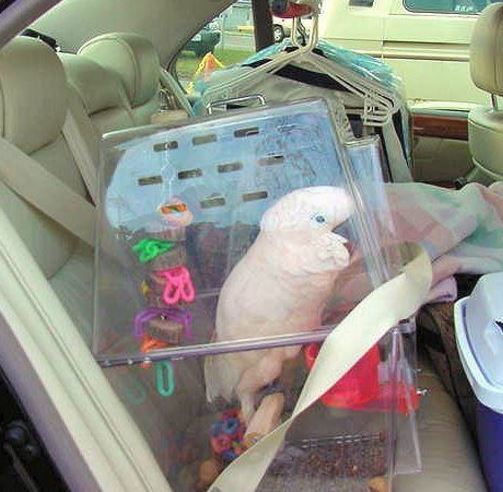Traveling with Birds
Preparation is key in all types of travel with pets, and birds are no exception. If you are planning more than just a trip across town, the further in advance you can prepare, the better. Flying with birds calls for even more research and preparation.
For short trips to the vet, a friend’s house, or setting out on a day trip, it’s best to get your pet used to the travel experience first. Pet birds can react to travel in different ways, depending on the type of species, temperant, weather, and other factors.
Always plan how you’re getting to your destination and in what type of cage or carrier you have in mind for your bird. Don’t buy a special travel cage without first making sure it’s going to fit appropriately in your vehicle or that it’s approved for bird airline travel.
By following these pet travel tips for traveling with birds, you can make the experience more enjoyable for both of you:
Driving with Birds
- Always secure your pet bird’s cage or carrier with a seat belt to prevent it from becoming a deadly projectile in the case of a sudden stop or crash.
- Avoid putting your bird’s cage or carrier in the front seat, especially if the vehicle is equipped with air bags. A sudden blow to the cage could have enough impact to be fatal to your feathered friend.
- Some birds travel better with a cage cover; others prefer to see what’s going on around them. Total darkness, however, can cause birds to stumble off their perch by bumps in the road or quick turns. Try different methods and levels of light to see how your bird responds best.
- If the weather is very hot or cold, windy or raining, a cover can help to protect your bird from the elements. If your trip can wait for a better day, opt to reschedule when the weather is not such a factor.
- Be attentive to your pet bird’s surroundings, being careful to avoid such things as loud car radio music; too cold or too hot air from the air conditioner or heater; cigarette smoke; air fresheners; and other irritants that can be uncomfortable to your pet bird.
- Depending on how long you may be gone on your trip, take along enough supply of your bird’s favorite food. A particular brand may not be readily available in another city or state.
- Water dishes in a travel cage don’t work especially well when being moved about. Try a non-spillable water bottle if your bird isn’t already familiar with using one.
- Favorite treats and toys are essential to provide a sense of comfort and familiarity in a strange place or while traveling.
- If traveling interstate, be sure to check local regulations, restrictions or quarantines regarding the species of your particular bird.
Flying with Birds
- Always check with your airline well in advance of your trip to understand its bird travel policy. Not all “pet-friendly” airlines permit birds. If they do, it’s important you find out about various restrictions, such as whether birds are allowed in the cabin, carrier size, bird size, species, etc.
- If you are planning to fly internationally with your pet bird, you may find out that only cargo storage is acceptable. Even then, there may be restrictions on how many hours birds are allowed to stay in the cargo area.
- As with other pets, be sure to obtain a necessary health certificate no more than 10 days prior to your flight and carry with you all important papers regarding your pet bird.
- It’s a good idea to have your bird banded when flying internationally.
- Bottom line is to make sure your pet bird is comfortable when traveling by air, with plenty of room to move around in a travel cage, while still comforming to the airline’s pet travel policies.
Check out the United States Department of Agriculture’s Animal and Plant Health Inspection Service (APHIS) website for more information about pet travel to other countries.
Here are some other resources for pet travel regulations:
Convention on International Trade in Endangered Species of Wild Fauna and Flora(CITES)
Veterinary Services (VS)
Here is some more information about Traveling Outside of the U.S. With Your Pet Bird that you may find helpful.
Pingback: Pet Emergency Preparedness | Small Animal Planet